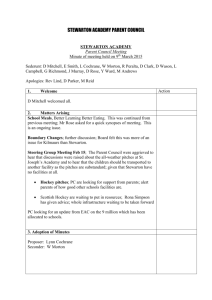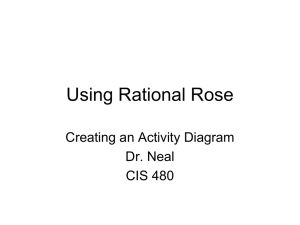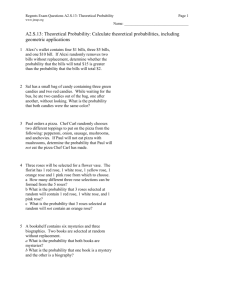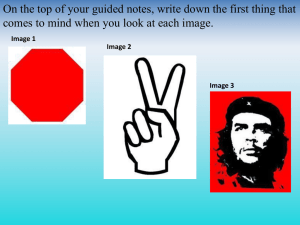Analysis of Geriatric Care Needs Paper
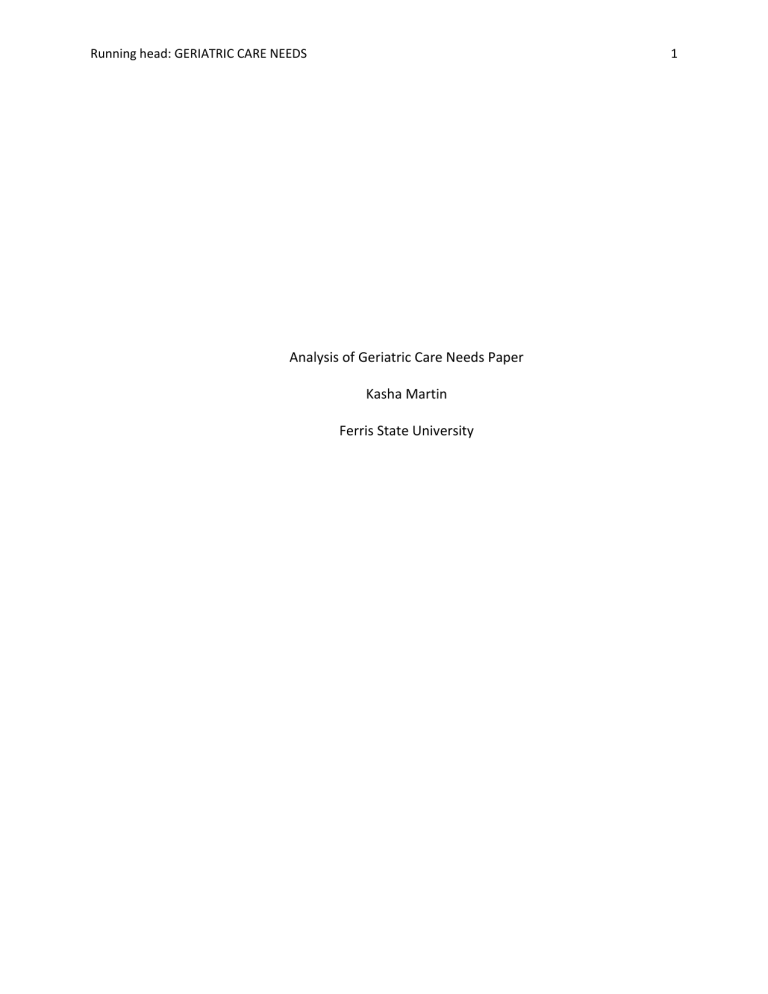
Running head: GERIATRIC CARE NEEDS
Analysis of Geriatric Care Needs Paper
Kasha Martin
Ferris State University
1
GERIATRIC CARE NEEDS 2
Abstract
The following paper describes 78-year old Rose who lives alone with no informal supports. Her case is assessed by a nurse. Nursing diagnoses are completed along with the intervention of home care and a home care nurse. Issues include knowledge deficit related to medications, fluid volume excess related to compromised cardiac output, and activity intolerance related to fatigue. Rose’s plan of care is completed. Outcomes are made with a timeframe of 3 months. Rose’s plan to put her on the right track to a better quality of life is discussed.
GERIATRIC CARE NEEDS 3
Analysis of Geriatric Needs Paper
The process of assessing older adults is different than assessing younger adults as it is more detailed and also requires special abilities of the nurse which include: listening patiently, allowing pauses, asking questions that are not often asked, observing minute details, obtaining data from available resources, and recognizing normal changes associated with late life that may be considered abnormal in someone who is younger (Ebersole and Hess, 2012). This kind of assessing is important as it allows the nurse to gather needed and important information so that a plan of care can be developed for the individual being assessed and assisting the person to have the best quality of life possible. In the following paragraphs, a comprehensive assessment of a hypothetical person will be shared as well as the nursing diagnoses, planning, implementation and evaluation of interventions associated.
Assessment
There are many things that need to be considered when assessing an elder. It is important for the nurse to be able to take the background information on a person and dig deeper into other problems that may be going on. According to the case study of Ebersole and
Hess (2012):
“Rose is a 78 year old widow who lives alone in the large city. When her now grown adult children were very small, her and her husband moved from the “old country” to the
United States where Rose still practices the “old country” ways. Rose speaks a mixture of
English and her native tongue and only has a few years of primary education. She has many complaints of aches and pains, knees that “give out”, “sugar” and “water” problems, and heart palpitations. She has a diagnosis of mild diabetes and congestive heart failure (CHF). Rose
GERIATRIC CARE NEEDS 4 regularly attends Catholic Church and her social life consists of church events, and seeing various physicians. Rose appears to be confused when it comes to properly adhering to prescribed medications” (p. 146). It is based on this case study, more information can be obtained when the nurse asks her more questions.
Based on the case study above and further assessing by the nurse (see Appendix A for comprehensive tool used) it is found that Rose lives alone without any formal or informal caregivers. She feels safe where she lives, but feels help would be beneficial. Rose has advanced directives and a copy is kept at the local hospital and with her primary physician. Her children are aware of her wishes and son is her DPOA when she is no longer able to make her own decisions. They visit only occasionally and offer only emotional support.
Rose feels her functional status is not up to her standards and realizes she needs assistance with things such as instrumental activities of daily living (IADL) and activities of daily living (ADL) as she becomes fatigued easily due to her diagnosis of CHF. Rose also states she is unable to drive and she does not like to walk long distances because sometimes she falls because her “knees just give out.” Rose also complains of “aches and pains” associated with a high amount of activity and swelling of her lower extremities, again, due to her diagnosis of
CHF.
When it comes to geriatric syndromes it is found that Rose has trouble taking her medications as she “can’t keep them straight” and often misses her diuretic because she does not like to take them when she goes to her church events because she “can’t stay out of the bathroom” and has problems with “stress incontinence.” Rose states she does not wear any kind of incontinence supplies and does not want to “risk it.” She states this worries her
GERIATRIC CARE NEEDS 5 because she is supposed to watch her weight so she does not “retain too much water,” but her social functions are important to her as there “is no one at home to visit with.”
As far as cognition goes for Rose, she states she is too busy to be depressed and she states she remembers well, but forgets small things. For instance, these things include forgetting why she went into the kitchen or somebody’s name she just met that day. She also states she loses track of time and forgets her medication and “there’s too many of them to keep track of anyway.” Rose states she “does not forget the important things.” This assessment shows all of Rose’s issues from a medical stand point based on her diagnoses.
However, what is associated with the fact that Rose is just getting older?
Biological Theories
The biological theory of aging explains why her conditions are happening, not because she is unhealthy or sick, but because she is just aging. According to Ebersole and Hess (2012), the biological theory of aging is “an exceedingly complex, genetically regulated, interactive process of changes” (p. 34). For instance, Rose’s mild diabetes could be related to the
Oxidative Stress Theory in which damage occurs to the body from free radicals because over time and as the body ages, the body’s ability to remove them decreases (Ebersole and Hess,
2012). Another biological theory of Rose’s “knees giving out” for unknown reasons could be due to the Cross-linkage Theory in which errors in the body are associated with cross-linked proteins and can cause damage to collagen, which in Rose’s case can affect the tendons in her knees.
GERIATRIC CARE NEEDS 6
Assessment Findings
According to the above information obtained from the nurse in the assessment, Rose has three things that are a priority and should be addressed appropriately. These things are knowledge deficit as she does not adhere to medications appropriately, fluid volume excess as she does not take medications as prescribed, and activity intolerance as she is unable to complete IADLs and some ADLs like bathing. With these three issues, the nurse is now able to make nursing diagnoses.
Diagnosis
1.
Knowledge deficit related to medication not being taken appropriately as evidenced by
Rose stating “there are too many of them to keep track of anyway” (Wilkinson and
Ahern, 2009).
2.
Fluid volume excess related to decreased cardiac output as evidenced by bilateral lower leg extremity +3 pitting edema (Wilkinson and Ahern, 2009).
3.
Activity intolerance related to insufficient oxygen secondary to decreased cardiac output as evidenced by Rose stating she becomes “fatigued easily because of my CHF.”
Planning
The purpose of planning is so that the nurse can assist Rose in enhancing her personal status, decrease the severity of chronic conditions, and encourage self-efficacy and empowerment for self-care (Ebersole and Hess, 2012). As far as the nursing diagnoses for Rose, her plan of care will be as follows:
1.
Knowledge deficit: provide teaching at Rose’s level of understanding, repeating information as necessary (Wilkinson and Ahern, 2009).
GERIATRIC CARE NEEDS 7
2.
Fluid volume excess: promotion of fluid balance to prevent complications resulting from abnormal or undesired fluid levels and maintenance of urinary elimination
(Wilkinson and Ahern, 2009).
3.
Activity intolerance: assist with ADLs and IADLs by instructing needed information for
Rose to function in the home or in the community (Wilkinson and Ahern, 2009).
Implementation
After the plan of care is developed, it is now the nurse’s job to assist Rose in implementing the plan. The nurse understands that the plan of care is what needs to happen to assist Rose in optimizing her health and assisting her in the best quality of life possible. In order to implement the plan of care the nurse has referred her to her local Area Agency on
Aging (AAA).
Intervention #1
AAAs were established under the OAA in 1973 to assist the needs of those over the age of 60 and assist with things such as declining health, mobility, independence, vision, hearing, and/or loss of spouse and these things can place older adults at greater risk for physical and/or psychological decline (Smith, 2010). The AAA can help Rose by implementing supportive services such as a nurse to assist with medication management and assisting in monitoring her fluid excess, as well as providing home health aides to assist with ADLs and IADLs (Smith, 2010).
Rose has mentioned above how “there are too many to keep track of” in regards to her medication. Marek, Stetzer, Ryan, Bub, Adams, Schlidt, Lancaster, and O’Brien (2013) state
“Medications are keys to the treatment of many chronic illness, but taking medications as prescribed is a complex task as dosage schedules may be complex, with multiple prescriptions
GERIATRIC CARE NEEDS 8 taken at different frequencies using a variety of actions needed to enact a regimen as well as frequent changes in medication dosage, frequency, or both.” A nurse that an AAA would set up for Rose would be beneficial for her as it is found that “nurse care coordination has a beneficial effect on cognitive functioning, depressive symptoms, functional status, and quality of life in both mental and physical functioning” (Marek, Stetzer, Ryan, Bub, Adams, Schlidt, Lancaster, and O’Brien (2013). It was also found that “nurse care coordinators were current on all medications, medical diagnoses, and prescribing providers and clearly understood the selfmanagement ability of each participant and focus on medication management connected nurse coordinators with participants via planned weekly telephone calls and every-other-week visits to the home” (Marek, Stetzer, Ryan, Bub, Adams, Schlidt, Lancaster, and O’Brien, 2013). With the implementation of a nurse, Rose would have someone to teach her how to track and take her medications as well as set them up in a way that would be easy for her to understand based on her learning needs.
Intervention #2
The second intervention that would need to be implemented for Rose would not only be the home care nurse mentioned above, but also to learn about the maintenance of urinary elimination. Receiving teaching about medications will likely allow Rose to take the necessary diuretic to assist with maintaining appropriate fluid balance and with weekly calls and home visits the nurse will also be able to monitor weight and fluid retention.
Adhering to appropriate medications to balance fluid volume allows “control of sodium and fluid retention and vasodilator and inotropic support” (Guthery and Schumann, 2007). In addition to taking the appropriate medications it is important for Rose to weigh herself daily
GERIATRIC CARE NEEDS 9 and to keep a record of her weight as an increase of 1 or 2 kg may indicate the need to for a doctor’s visit where the doctor may need to adjust her medication regimen (Guthery and
Schumann, 2007). However, as mentioned above, the home care nurse implemented by the
AAA will assist with these matters. However, with Rose being back on track with her diuretic, she will need to learn how to maintain urinary elimination because as before she has stated “I can’t stay out of the bathroom.”
Urinary elimination maintenance is important because this will allow Rose to attend her regular social activities without having to worry about rushing to the restroom all the time or having a urinary accident. When Rose gets back on track with her medication it is important for her to track her urinary elimination patterns (Merkylj, 2002). After a pattern is identified, Rose can begin kegel exercises to strengthen her pelvic floor and then slowly begin to retrain her bladder (Merkylj, 2002). Retraining the bladder involves a scheduled voiding regimen while gradually increasing voiding intervals, as well as urgency control strategies including distraction and relaxation techniques, and self-monitoring (Merkylj, 2002). This is something, that again, the home health care nurse can assist Rose with as well as encouraging her to wear protective garments while in the process of retraining her bladder and maintaining her urinary elimination patterns.
Intervention #3
The final intervention for Rose is for the AAA to implement a home health care aide to assist Rose with ADLs and IADLs. With activity intolerance, it is difficult for Rose to finish ADLs such as bathing and IADLs such as homemaking due to becoming fatigued easily related to her diagnosis of CHF.
GERIATRIC CARE NEEDS 10
According to Sue (2007), patients with congestive heart failure often complain of exertional dyspnea and fatigue, and, therefore, of their reduced ability to function and perform the activities of daily living. With a home health aide, fatigue could be lessened by assisting
Rose with deep cleaning her home, and assisting her in the shower to keep an eye on her so she does not become so fatigued she might fall. Again, getting Rose back on track with her medication regimen could also be helpful in helping her gain more energy and not feel so tired all the time.
Evaluation
Knowledge Deficit
Rose will demonstrates knowledge of medication regimen as evidenced by describing prescribed medications and uses, describing rationale for each medication taken, describing appropriate times medications should be taken (Wilkinson and Ahern, 2009). She will also accept formal supports. Rose will have completed each of these tasks by the end of three months.
Fluid Volume Excess
Fluid balance will not be compromised in excess as evidenced by 24-hour intake and output self-monitoring, stable body weight, and appropriate urinary elimination maintenance (Wilkinson and Ahern, 2009). She will also accept formal supports. Rose will have completed each of these tasks by the end of three months.
Activity Intolerance
Rose will demonstrate activity tolerance as evidenced by recognizing energy limitations, balancing activity and rest, and organizing activities to conserve energy (Wilkinson and Ahern,
GERIATRIC CARE NEEDS 11
2009). Rose will also accept formal supports. Rose will have completed each of these tasks by the end of three months.
Public Policy
As far as unmet needs for Rose, the nurse may not think of any at this time, but may after other interventions may be implemented. For instance, Rose’s medications were prescribed, but how was the confusion of taking them missed by the doctor and why was this not addressed sooner? Roth, Esserman, Ivey, and Weinberger (2009) state “medication-related problems are prevalent in older adults and adversely affect the quality of care.” Since this is so prevalent in older adults, this nurse feels public policy should address this issue and it should start in the physician’s office.
Conclusion
Rose is at a state where she can continue to decline given her diagnoses, or she can improve with a little help at home. It is shown that receiving home care with “frequent visits and prompt delivery of medical care prevent delay in therapy, clinical progression of disease, and recurrent hospitalization” and there is a “statistically significant decrease in all four categories of congestive heart failure symptoms such as paroxysmal nocturnal dyspnea, orthopnea, dyspnea upon exertion, and pedal edema” (Maliakkal and Sun, 2014). Since Rose lives alone and her children provide only emotional support, it is important for her to get on the right track. Implementing services from the AAA will be beneficial to her and hopefully help her to live a more independent life with the best possible quality.
GERIATRIC CARE NEEDS 12
References
Comprehensive geriatric assessment. (2009). Emory university school of medicine. Retrieved from:http://www.medicine.emory.edu/divisions/geriatrics/education/edu_resources/as sesment_tools/index.cfm
Guthery, D., Schumann, L. (2007). Continuing education forum: Congestive heart failure. Journal of the American association of nurse practitioners. Vol 10(1). p 31-38. doi:
10.1111/j.1745-7599.1998.tb00464.x
Maliakkal, A.V., Sun, A.Z. (2014). Home care program reduces hospital readmissions in patients with congestive heart failure and improves other associated indicators of health. Home health care management practice. Vol 26(4). p 191-197. doi:
10.1177/1084822314527763
Marek, M.D., Stetzer, F., Ryan, P.A., Bub, L.D., Adams, S.J., Schlidt, A., Lancaster, R., O’Brien, A.
(2013). Nurse care coordination and technology effects on health status of frail older adults via enhanced self-management of medication: Randomized clinical trial to test efficacy. Nursing Research.
Lippincott Williams & Wilkins. Vol. 62(4). p. 269-278. doi:
10.1097/NNR.0b013e318298aa55
Merkelj, I. (2002). Basic assessment of urinary incontinence. Southern medical journal. Vol.
95(2). p 178. Retrieved from: http://0go.galegroup.com.libcat.ferris.edu/ps/i.do?ty=as&v=2.1&u=lom_ferrissu&it=search&s=
RELEVANCE&p=ITOF&qt=SP~178~~IU~2~~SN~0038-4348~~VO~95&lm=&sw =w
GERIATRIC CARE NEEDS 13
Roth, M. T., Esserman, D. A., Ivey, J. L., & Weinberger, M. (2010). Racial Disparities in the
Quality of Medication Use in Older Adults: Baseline Findings from a Longitudinal Study.
Journal of General Internal Medicine, 25(3), 228–234. doi:10.1007/s11606-009-1180-9
Smith, J. (2012). Area agency on aging: A community resource for patients and family. Home healthcare nurse: The journal for the home care and hospice professional. Lippincott
Williams & Wilkins, Inc. Vol. 28(7). p 416–422. doi: 10.1097/NHH.0b013e3181e32552
Sue, D.Y. (2000). Exertional dyspnea in congestive heart failure: Living longer and doing more.
Chest journal. Vol 118(1). p 5-7. doi: 10.1378/chest.118.1.5
Touhy T.A., Jett, K. (2012). Ebersole and Hess’ toward healthy aging: human needs and nursing response. Elsevier Mosby: St. Louis MO.
Wilkinson, J.M., Ahern, N.R. (2009). Nursing diagnosis handbook. Pearson: Prentice Hall. Upper
Saddle River, NJ.
GERIATRIC CARE NEEDS 14
Appendix A.
Geriatric Assessment
Domain(s)
Social Support
Big 10 Principle
Recommended Screens
5 , 9
Do you live alone?
Do you have a caregiver?
Are you a caregiver?
SOCIAL
Elder
Neglect/Abuse
Advance
Directives
Functional
Status
Driving
5
4
4
,
10
,
,
6
6
6
Further Assessment for Positive Screen
Consider referral to social worker
Do you ever feel unsafe where you live?
Has anyone ever threatened or hurt you?
Has anyone been taking your money without your permission?
Would you like information or forms for a power of attorney for healthcare?
Would you like information on a living will?
Do you need assistance with shopping or finances?
Do you need assistance with bathing or taking a shower?
Do you still drive? If yes:
While driving, have you had an accident in the past 6 months?
Driving concerns by family member?
Refer to area Agency on Aging
Atlanta (404) 463-3333
Social Work Assessment
Consider Adult Protective Services referral
Discussion on advance directives
Instrumental ADL Scale
Basic ADL Scale
Vision testing
Consider Occupational Therapy evaluation
FUNCTIONAL
Vision
1 , 3 , 4
Do you have trouble seeing, reading, or watching TV? (with glasses, if used)
Driving Concerns by family member
Vision testing
Hearing
Medications
Fall Risk
1
2
,
,
3
8
, 4
Consider referral to optometry or opthalmology
Do you have difficulty hearing conversation in a quiet room?
Unable to hear whisper test 6-12 inches away?
Cerumen check and removal if impacted
Consider Audiology referral
Are you prescribed > 5 routine medications? Match medications with diagnoses in problem list
Do you have difficulty understanding the reason for each of your medications?
Consider reducing doses or discontinuing drugs
Have you fallen in the past year?
Are you afraid of falling?
Do you have trouble climbing stairs or rising from chairs?
"Get Up and Go" test
Consider full Fall Assessment
2 , 3 , 6
Consider Physical Therapy Evaluation
GERIATRIC
SYNDROMES
Continence
Sleep
Pain
2
2
,
,
3
Weight Loss
2 , 3
3
2 , 3
Alcohol Abuse 3 , 5
Consider Home Safety Assessment
Do you have any trouble with your bladder?
Do you loose urine when you do not want to?
Do you wear pads or adult diapers?
Consider full Continence Assessment
AUA 7 symptom inventory (men)
Weight < 100 lbs, or
Unintentional weight loss > 10 pounds over
6 months?
Simplified Nutritional Appetite Questionnaire (SNAQ)
Consider Nutrition evaluation
Do you often feel sleepy during the day?
Do you have difficulty falling asleep at night?
Epworth Sleepiness Scale
Consider referral for sleep evaluation
Review good sleep hygiene
Are you experiencing pain or discomfort? Pain Assessment
Do you drink > 2 drinks / day? CAGE Questionnaire
GERIATRIC CARE NEEDS 15
Depression
COGNITION
AND AFFECT Cognition
7
7
Do you often feel sad or depressed?
Have you lost pleasure in doing things over the past few months?
Self reported memory loss?
Cognitive Screen positive? (3-item recall and Clock Draw test)
Geriatric Depression Scale
Mini Mental Status Exam
Consider Neuropsychological testing

